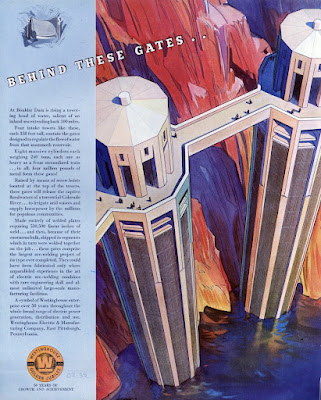The Hoover Dam is a concrete arch-gravity dam in the Black Canyon of the Colorado River, on the border splitting Nevada and Arizona. From 1931 to 1936, over four million cubic yards of concrete and eighty-eight million pounds of plated steel were used. And with the removal of rock from the canyon walls, boring four diversion tunnels, and the sacrifice of more than 100 lives, the dam quickly became a symbol of the American "can-do" spirit. For millions of people in the 1930s, Hoover Dam, and on a lesser scale, the Empire State Building, came to symbolize what American workers could do even in the depths of the Great Depression.
When President Herbert Hoover lost the White House in 1932 to President Roosevelt, his new Interior Secretary, Harold Ickes, snubbed the Hoover name from the day of the dam’s dedication. “This great engineering achievement should not carry the name of any living man but, on the contrary, should be baptized with a designation as bold and characteristic and imagination-stirring as the dam itself.” His political bias blotted out the fact that Presidents Woodrow Wilson, Theodore Roosevelt, and Calvin Coolidge already had dam sites attached to their names.
As a former mining engineer, Hoover took an active part in settling the engineering problems and the location of the dam in Black Canyon. When he left office, construction finished more than a year ahead of schedule. The Hoover name was vindicated when House Resolution 140 was introduced and passed by the 80th Congress in 1947. President Harry S. Truman signed the resolution and restored the name Hoover Dam to the structure. To clarify, the names "Boulder Canyon Dam" and "Boulder Dam" were simply references to nearby Boulder City, Nevada, and not official. Almost a million people still come to visit the huge dam every year.
Note: The illustration above highlights the intake towers before Lake Mead was filled to its normal operating level.



